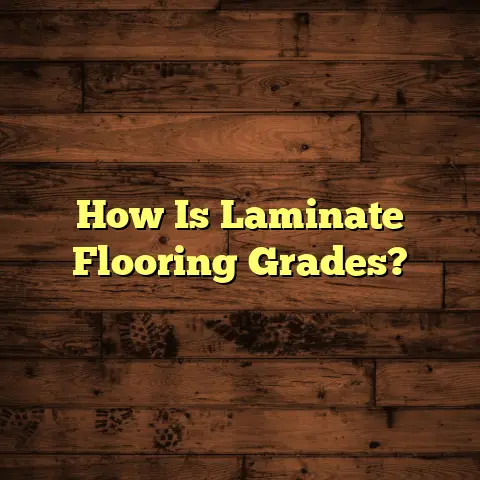Remove Paint Off Wood Floors (5 Green Tips!)
I get it. It’s all about finding that perfect harmony, and often, the unsung hero of any room is the wood floor beneath your feet.
These floors whisper stories of the past, adding character and warmth. But what happens when a splash of paint threatens to silence that story?
That’s where I come in. As a flooring contractor with years of experience, I’ve seen my fair share of paint-splattered disasters (and triumphs!).
And let me tell you, preserving the natural elegance of your wood floors while staying eco-friendly is totally achievable.
With the growing trend of eco-conscious home improvements, it’s more important than ever to find sustainable ways to tackle these challenges.
So, grab a cup of coffee (or tea!), and let’s dive into my top 5 green tips for effectively removing paint from your wood floors.
Section 1: Understanding the Types of Paint
on Wood Floors
Okay, before we even think about scrubbing, it’s crucial to know what kind of paint we’re dealing with. Think of it like diagnosing the problem before prescribing the cure.
Oil-Based vs. Water-Based Paints
The two main culprits you’ll encounter are oil-based and water-based paints. The difference? Their composition and how they bond with the wood.
Oil-based paints are durable and create a tough finish. They’re known for their slow drying time and require solvents like mineral spirits for cleanup.
Water-based paints, on the other hand, are generally easier to work with. They dry faster, are low in VOCs (volatile organic compounds), and clean up with water.
How do you tell the difference? Honestly, it can be tricky! One trick I often use is to dab a cotton ball soaked in rubbing alcohol on the paint.
If the paint softens or comes off easily, it’s likely water-based. If it resists, you’re probably dealing with oil-based paint.
Knowing this difference is key because it directly influences the removal method. Water-based paints are generally easier to remove than their oil-based counterparts.
Paint Finishes and Their Effects
Now, let’s talk finishes: matte, glossy, satin, and everything in between. These finishes affect how the paint interacts with the wood surface and, you guessed it, the removal process.
Glossy paints, for example, create a hard, smooth surface that can be more resistant to removal. Matte paints, on the other hand, tend to be more porous and might seep deeper into the wood grain.
From my experience, the tougher the finish, the more elbow grease (or a slightly stronger solution) you’ll need.
Historical Considerations
Here’s a history lesson with a twist. If you’re dealing with an older home (pre-1978), there’s a chance the paint contains lead.
Lead paint is a serious health hazard, especially for children and pregnant women. If you suspect lead paint, don’t mess around!
I strongly recommend contacting a certified lead abatement professional to handle the removal safely. They have the expertise and equipment to protect you and your family.
For more information on lead paint safety, check out the EPA’s website: https://www.epa.gov/lead.
Section 2: Eco-Friendly Methods for Paint
Removal
Alright, now for the good stuff! Let’s get into the green methods I’ve personally used and recommend for removing paint from wood floors.
Citrus-Based Solvents
Citrus solvents are my go-to for tackling paint without harsh chemicals. They’re made from natural citrus peels and have a pleasant smell (a huge plus compared to traditional solvents!).
How do they work? The citrus oils penetrate the paint, breaking down its bond with the wood.
Here’s my step-by-step guide:
- Ventilate: Open windows and doors to ensure good airflow.
- Apply: Generously apply the citrus solvent to the painted area.
- Wait: Let it sit for the recommended time (usually 30 minutes to an hour).
- Scrub: Use a natural bristle brush or a plastic scraper to gently remove the softened paint.
- Clean: Wipe the area with a damp cloth to remove any residue.
Pro Tip: For stubborn spots, reapply the solvent and let it sit longer.
Vinegar and Baking Soda Paste
This is a classic DIY solution that’s both effective and budget-friendly. Vinegar is a mild acid that helps to soften the paint, while baking soda acts as a gentle abrasive.
Here’s how to make the magic happen:
- Mix: Combine equal parts vinegar and baking soda to create a thick paste.
- Apply: Spread the paste over the painted area.
- Wait: Let it sit for several hours or even overnight.
- Scrub: Use a scrub brush or a plastic scraper to remove the softened paint.
- Clean: Wipe the area with a damp cloth and let it dry.
Safety First: While vinegar and baking soda are generally safe, avoid getting the paste in your eyes.
Steam Cleaning
Steam cleaning is an excellent option for removing paint without any chemicals. The hot steam loosens the paint, making it easier to scrape away.
Here’s how to steam clean safely:
- Prepare: Fill your steam cleaner with water according to the manufacturer’s instructions.
- Steam: Hold the steam cleaner nozzle a few inches away from the painted area.
- Scrape: Use a plastic scraper to gently remove the loosened paint.
- Dry: Wipe the area with a clean cloth to remove any moisture.
Important: Avoid prolonged exposure to steam, as it can damage the wood. Work in short bursts and keep the steam cleaner moving.
Natural Scrubbing Techniques
Sometimes, the simplest methods are the most effective. Natural bristle brushes and scrapers can work wonders, especially for smaller paint splatters.
Here’s the technique:
- Choose: Select a natural bristle brush with firm bristles.
- Scrub: Gently scrub the painted area in a circular motion.
- Scrape: Use a plastic scraper to remove any remaining paint.
- Clean: Wipe the area with a damp cloth.
Why natural bristles? They’re less likely to scratch the wood than synthetic bristles.
Recycling Old Paint
Okay, you’ve removed the paint from your floors, but what about the leftover paint in the can? Don’t just toss it in the trash!
Many communities have paint recycling programs where you can drop off unwanted paint. Check with your local waste management company or search online for paint recycling centers near you.
Why recycle? It reduces waste, prevents harmful chemicals from entering the environment, and conserves resources.
Section 3: Preventing Future Paint Mishaps
on Wood Floors
Prevention is always better than cure, right? Here are some tips to protect your wood floors from future paint disasters.
Protective Coatings
Applying a protective finish to your wood floors before painting can create a barrier that prevents paint from bonding directly to the wood.
Eco-friendly options include:
- Water-based polyurethane: Low in VOCs and provides excellent protection.
- Natural oil finishes: Made from plant- based oils and waxes.
Using Drop Cloths and Taping
This is a no-brainer, but it’s worth repeating. Always use drop cloths to protect your floors from paint spills. Secure the edges with painter’s tape to prevent the drop cloth from shifting.
Pro Tip: Use canvas drop cloths instead of plastic. They’re more durable, absorbent, and eco-friendly.
Choosing the Right Paint
When selecting paint for your next project, opt for low-VOC or no-VOC paints. These paints are less likely to cause harm to the wood or the environment.
Why low-VOC? VOCs are chemicals that evaporate from paint and can contribute to air pollution.
Section 4: When to Seek Professional Help
Sometimes, DIY isn’t the answer. Here’s when it’s time to call in the pros.
Identifying Severe Damage
If the paint has deeply penetrated the wood, or if you’ve accidentally damaged the floor during the removal process, it’s best to consult a professional.
Signs of severe damage include:
- Deep scratches or gouges
- Discoloration or staining
- Warping or buckling of the wood
Consultation with Flooring Experts
Look for flooring experts who specialize in wood floor restoration and are committed to eco-friendly practices.
How to find them?
- Ask for referrals from friends or family.
- Check online directories for certified flooring contractors.
- Look for contractors who use sustainable materials and methods.
Cost Considerations
Professional wood floor restoration can be expensive, but it’s often worth the investment. The cost will depend on the extent of the damage and the type of finish you choose.
Consider the long-term benefits:
- Restoring the beauty and value of your wood floors
- Preventing further damage
- Ensuring a safe and healthy home environment
Section 5: Case Studies and Success Stories
Let’s get inspired by some real-life examples of homeowners who successfully removed paint from their wood floors using eco-friendly methods.
Homeowner Testimonials
“I had a huge paint spill on my oak floors, and I was devastated,” says Sarah, a homeowner from California. “I tried the vinegar and baking soda paste, and it worked like a charm! I was so relieved to be able to remove the paint without using harsh chemicals.”
Another homeowner, John, from New York, shared his experience with citrus-based solvents. “I was skeptical at first, but the citrus solvent worked wonders on the oil-based paint splatters in my living room. Plus, it smelled amazing!”
Before and After Comparisons
I worked with a client whose floors had been covered in layers of old paint for decades. We used a combination of steam cleaning and natural scrubbing techniques to remove the paint and reveal the beautiful wood underneath.
The transformation was incredible! The floors went from dull and lifeless to warm and inviting. It was a testament to the power of sustainable home improvement.
Conclusion
So, there you have it! My top 5 green tips for removing paint from wood floors. Remember, maintaining your wood floors is not just about aesthetics; it’s also about creating a healthy and sustainable home environment.
Embrace these green practices, and you’ll be able to effectively remove paint and protect the beauty of your wood floors for years to come.





